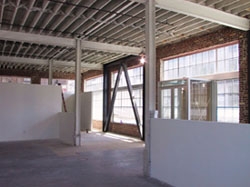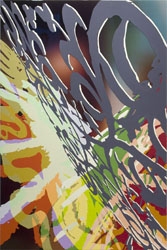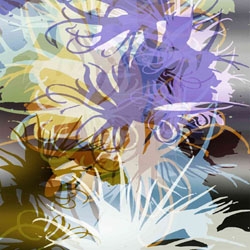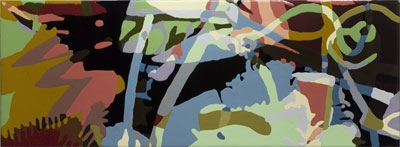Feature: Essays
Profile: Griff Williams
Both Griff Williams’s parents were in politics during the Reagan administration, battling conservative forces to advocate for education, labor, and the arts. Having lived through the attack on the National Endowment for the Arts with a ringside seat, Williams approached his post-MFA career with few illusions about the economic realities of a life in the arts. To make his way, he founded Urban Digital Color (UDC) and Gallery 16, a digital printmaking press and companion fine art gallery, in 1994. One of the first presses in the country to use contemporary digital printmaking methods to produce artist editions, UDC has worked with William Kentridge, David Hockney, Deborah Oropallo, Shaun O’Dell, Rebeca Bollinger, Todd Hido, Darren Waterston, and Rex Ray among others.
After twelve years in their original home, 1616 16th Street, the twin businesses are moving to a new ground floor location at the corner of Third and Bryant Streets in the South Park neighborhood June 1, 2006. This seemed like the perfect occasion to speak with Williams about his own work and ideas.
When a friend wrapped up a paint-by-numbers set as a gift for artist Griff Williams’s small son, he inadvertently gave Williams a gift, too—an inspiration that has carried him for five years and counting. Inspecting the 1950s Color Craft kit, Williams saw a system that he could reinvent on his own terms. “Making something that looks like it had been manufactured interested me,” he says. “Even in art school, there’s pressure on young artists to be constantly making things. Sometimes it seems as if the idea of output supersedes everything else. Something that looks mechanical or mass-produced seems very much of our times.”
Williams began with the simple structure of the paint-by-numbers form. He had a professional paint shop mix colors that exactly matched the colors in the set and went to work. “It’s a distinctive palette,” he says, “They had to make those sets cheaply so they always mixed a little bit of white into the colors to make the more expensive pigments stretch further. There are no primary colors, only muted, chalky tones. But with color, the impression is always created by the position of a color in the ensemble. Those softened colors can look very bright when they’re placed next to even duller hues.”
For the basic drawing, Williams began with found graphic elements, such as an attractive pattern stamped on the cover of an old book. After turning an iimage into a stencil, he layers it repeatedly into a phantasmagoria of forms. “There’s a gestalt aspect to these compositions,” he says. “One shape transitions into another shape and the overall form becomes camouflaged. You sense that there are similarities, but as the colors emphasize the intermediate forms, the original shape begins to disappear. Immense complexity emerges out of simplicity.”
Williams’s compositional system is rooted in a childhood fascination with hand-written letters from the Victorian era. Although he no longer remembers exactly where he first encountered them, he vividly recalls seeing densely written letters, so packed with hand-written script they became illegible. “They made palimpsests,” he says, “Because paper was precious, they would reuse one piece of paper, adding to it until every bit of space was covered with text.”
Instead of script, Williams’s recent works utilize illustrations from Charles Darwin’s journals. “There were just so many remarkable images. There were a number of expeditions in the 1800s that yielded remarkable illustrations, in notebooks created as a record of particular bodies of plant or animal life. All this stuff swirls together, pressed together into one flat record, like a mental geography.”
Williams’s sensitivity to mental geographies may also have been formed in childhood. Growing up in Montana, the son of a Congressman who traveled widely in the state with his family, Williams encountered Native American culture as a matter of course. “There was a difference between what I assumed art was and creative experience for the tribes. Many of them don’t have a separate word for ‘art,’ although they make beautiful objects. It’s just a functional part of life, merged with utilitarian aspects of their culture. It’s eye-opening for an artist to realize that what you’re doing has no meaning in a different cultural context.”




